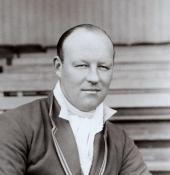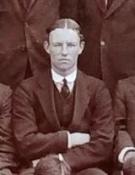
War Memorial
| Lieutenant Arthur William CARR | |
|
20th Hussars attached to A Squadron, 5th (Royal Irish) Lancers, Date of birth: 21st May 1893 Date of death: 7th February 1963 Died aged 69 Unknown |

|
| Arthur William Carr was born at Mickleham in Surrey on the 21st of May 1893 the elder son of Philip William Carr, a stockbroker and Louise S. (nee Yates) Carr of Dennett Lodge, Crockham Hill in Kent. He was christened at Mickleham on the 21st of June 1893. He was educated at Hazelwood School until July 1906 where he was a member of the Choir. He was a member of the Cricket XI in 1904, 1905 and 1906 when he was Captain. He was a member of the Football XI in 1904 and 1905. He won the school Gymnastics Prize in 1905. The school magazine wrote the following on his 1904 cricket season: - "Very good all round for his size, but too small to be much use yet." They wrote the following on his 1905 cricket season: - "For his inches would be quite in the 1st class; with a little more head, but at present is addicted to strokes that mean certain death. Is too small yet to do justice to his undoubted bowling talent. A fine field anywhere." Of his 1906 cricket season they wrote: - "As Captain, keen and energetic in the field, but should learn to discriminate between slackness and un-skilfulness in others. As a batsman, has had no superior here, possessing every stroke a boy of his age ought to have, his driving being perhaps his strongest point. His bowling hardly increased as much in accuracy as in pace. A beautiful field anywhere, from wicket keeper outwards." They wrote the following of his 1904 football season: - "(Half back) - "A brilliant performer, untiring alike in attack and defence; he must correct a tendency to excessive dribbling." Of his 1905 football season they wrote: - "(Centre half) - Magnificent both in defence and attack; has all the energy and grit, and much of the cleverness that combine to make a model half." On leaving the school the magazine wrote of him: - "...has also been suddenly called to Eton. In him Hazelwood loses a sportsman second to none, and his future will be looked upon with eager interest." He went on to Eton College where he was in Mr. J.H.M. Hare's House from September 1906 to July 1907 when he was asked to leave so went instead to Sherbourne School where he was in School House from September 1907 to July 1911. He was Captain of all school games except cricket. He represented the school at Aldershot in the Public School Boxing Competition in 1911. He was a member of the Cricket XI from 1909 to 1911, scoring over 1,000 runs in the 1909 season alone, and of the Rugby XV in 1911/12 when he was Captain. He also played for Nottinghamshire County Cricket Club 2nd XI in 1909. The Sherborne School magazine wrote the following of his 1910 cricket season: - "Very good bat, with any number of good shots, his best being his drive, which is very powerful. His fault is his great recklessness, getting himself out by treating full tosses and long hops too carelessly. A good field anywhere, at his best in the slips. A useful fast bowler, but cannot last long." Of his 1911 cricket season they wrote: - "A very fine bat. Excellent shots all round the wicket, his driving being brilliant. Has far more defence and steadiness than he had last year, but lacks grit in an uphill fight. Bowls well for a short time, but his action is too strenuous for him to last long; should never bowl more than five overs at a time. Brilliant, but not safe, in the field." The school magazine wrote the following of his 1911/12 rugby season: - "Captained his side well under conditions frequently depressing. Possessing strength, pace and good hands, he has great possibilities as a centre three quarter if he unlearns completely a tendency to slowing up and grows stronger in defence. Screw kicks beautifully." In 1910 he represented the Public Schools XI in the match against the MCC at Lords. On leaving school he made his first class debut for Nottinghamshire against Derbyshire at the age of 17, in the same season, scoring 1,800 runs but did not score his first century for the club until 1913. He was Captain of the Rugby XV in 1911 and he played football for Leicester City Football Club in 1912. On the 27th of September 1913 he was commissioned as a probationary 2nd Lieutenant in the 20th Hussars (Special Reserve of Officers) and on the outbreak of war he was attached to A Squadron, 5th (Royal Irish) Lancers. He embarked with them at Dublin aboard the SS “St Pancras” on the 16th of August 1914 landing in Le Havre at 12.30pm the following day. On the 20th of August he was sent on a reconnaissance patrol ten miles to the north of Mons and, although German cavalry was spotted, they were not engaged. They came into action for the first time on the 24th, sustaining a number of casualties including their commanding officer who was wounded. They were then involved in the long retreat from Mons where they acted as a rearguard to the retreating British Expeditionary Force. He was wounded and invalided home for four months during 1915, returning to the front at the end of the year and was mentioned in despatches. He was promoted to Lieutenant on the 1st of July 1917. At the end of 1917 he was injured by a horse falling on him which broke several bones in his foot. He was still serving with his regiment at the armistice in November 1918. In the summer of 1919 he resumed his career with Nottinghamshire Cricket Club as club captain, a position he held until 1934 when he gave up the job following a heart attack. He toured South Africa with the MCC in the winter of 1922/3 and was named Wisden Cricketer of the Year in 1923. Carr was named captain of England for the Ashes series against Australia in 1926. In the third Test at Leeds, he controversially put Australia into bat after winning the toss, and dropped Charlie Macartney at slip in the first over of the match. Macartney went on to score a hundred before lunch and England was lucky to avoid defeat. He came down with tonsillitis during the fourth Test of the series, and although he recovered in time for the fifth Test, he was replaced as captain by Percy Chapman. He was bitterly disappointed with this decision, and although he captained England twice more in his final two Tests against South Africa in 1929, henceforth he put most of his effort into captaining Nottinghamshire into a dominant position within the English County cricket competition. He became a test selector during the 1927 season. In 1930 and in the following years, Carr was instrumental in developing the "bodyline" bowling tactic together with future England captain Douglas Jardine and the two Nottinghamshire fast bowlers Harold Larwood and Bill Voce. Carr used the tactic of instructing his bowlers to aim at the bodies of batsmen and placing a close set field on the leg side to take catches fended away from the body with the bat and perfected it as he led Nottinghamshire to success in the county competition. Jardine then used Larwood and Voce in similar fashion on the infamous 1932-33 English tour of Australia, resulting in several injuries to Australian batsmen and the incurring the wrath of the Australian public. After this tour, and the subsequent fallout, Carr was subjected to bodyline bowling by other English county teams, and was severely shaken by several balls that nearly hit him on the head. He later denounced the tactic he had helped develop as unfair. Dissension within the Nottinghamshire club over his role in the bodyline scandal led him being sacked as captain in 1934, and he never played first-class cricket again. In all, he played 11 times for England with a batting average of 19.75. He also wrote a book, “Cricket with the Lid Off” with a preface by Douglas Jardine which was published in 1935. In his first class career he scored 21,100 runs including 45 centuries at an average of 31.58 and took 318 catches. During the Second World War he returned to the army joining the 16th/5th Lancers as a Lieutenant and served at Catterick from 1939 to 1941. He was married to Ivy Violet Lewin (nee Barton) at St Luke's Church, Chelsea on the 10th of February 1917. They had a son, Angus Arthur Philip, born in 1917. His wife died on the 23rd of November 1955 after which he lived with a Colonel's wife but never remarried. He collapsed and died at his home at Clumber Cottage, West Witton, near Leyburn in Yorkshire while shoveling snow. The Arthur Carr Sports Scholarship was instituted at Hazelwood School in his memory. His son, Lieutenant Angus Arthur Philip Carr 425 Battery, 107 (South Nottinghamshire Hussars) Regiment, Royal Artillery, was killed in action on the 27th of May 1942. |
|
 | |
| Went on to Sherbourne School |
Back